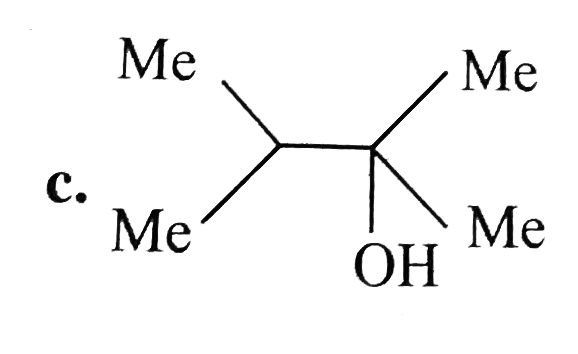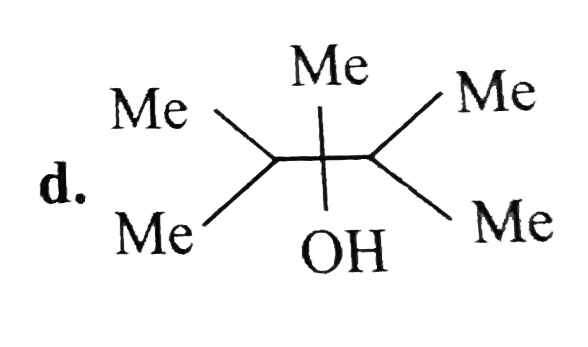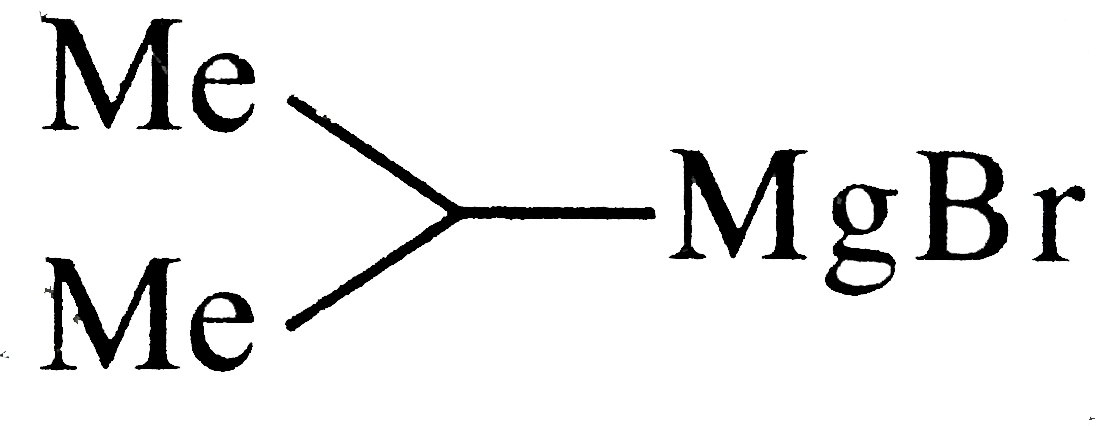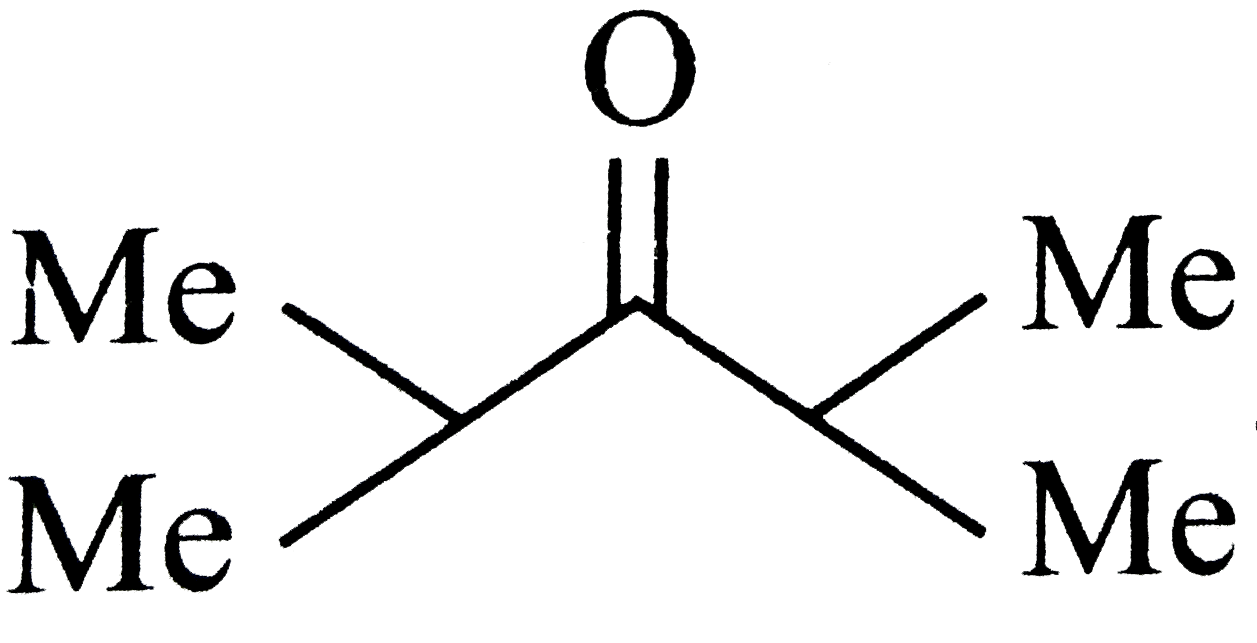When di-isopropyl cadmium is treated with ethanoyl chloride, the product is :




The correct Answer is:B
To solve the question of what product is formed when di-isopropyl cadmium is treated with ethanoyl chloride, we can follow these steps:
Step 1: Identify the Reactants
- Di-isopropyl cadmium is represented as (CH3)2CH-Cd. This means it has two isopropyl groups attached to cadmium.
- Ethanoyl chloride (also known as acetyl chloride) is represented as CH3COCl.
Step 2: Understand the Reaction Mechanism
- Di-isopropyl cadmium is a nucleophile due to the presence of the cadmium atom, which can donate electrons.
- Ethanoyl chloride, on the other hand, is an acyl chloride that can undergo nucleophilic attack due to the electrophilic carbon in the carbonyl group (C=O).
Step 3: Draw the Structures
- Draw the structure of di-isopropyl cadmium:
CH3|CH3−C−Cd|CH3
- Draw the structure of ethanoyl chloride:
O∣∣CH3−C−Cl
Step 4: Perform the Nucleophilic Attack
- The nucleophile (di-isopropyl cadmium) attacks the carbonyl carbon of ethanoyl chloride, leading to the formation of a tetrahedral intermediate.
- The chloride ion (Cl-) is expelled during this process.
Step 5: Form the Product
- The product formed after the nucleophilic attack is:
O∣∣CH3−C−(C(CH3)2)
- This product is 2-isopropyl-2-oxopropane (or 2-isopropylacetone) along with cadmium chloride (CdCl2) as a byproduct.
Step 6: Write the Final Equation
- The overall reaction can be summarized as:
2(CH3)2CH−Cd+2CH3COCl→2(CH3)2C(=O)CH+CdCl2
Conclusion
The product formed when di-isopropyl cadmium is treated with ethanoyl chloride is 2-isopropyl-2-oxopropane (or 2-isopropylacetone) along with cadmium chloride.
- Di-isopropyl cadmium is represented as (CH3)2CH-Cd. This means it has two isopropyl groups attached to cadmium.
- Ethanoyl chloride (also known as acetyl chloride) is represented as CH3COCl.
- Di-isopropyl cadmium is a nucleophile due to the presence of the cadmium atom, which can donate electrons.
- Ethanoyl chloride, on the other hand, is an acyl chloride that can undergo nucleophilic attack due to the electrophilic carbon in the carbonyl group (C=O).
- Draw the structure of di-isopropyl cadmium:
CH3|CH3−C−Cd|CH3
- Draw the structure of ethanoyl chloride:
O∣∣CH3−C−Cl
- The nucleophile (di-isopropyl cadmium) attacks the carbonyl carbon of ethanoyl chloride, leading to the formation of a tetrahedral intermediate.
- The chloride ion (Cl-) is expelled during this process.
- The product formed after the nucleophilic attack is:
O∣∣CH3−C−(C(CH3)2)
- This product is 2-isopropyl-2-oxopropane (or 2-isopropylacetone) along with cadmium chloride (CdCl2) as a byproduct.
- The overall reaction can be summarized as:
2(CH3)2CH−Cd+2CH3COCl→2(CH3)2C(=O)CH+CdCl2
The product formed when di-isopropyl cadmium is treated with ethanoyl chloride is 2-isopropyl-2-oxopropane (or 2-isopropylacetone) along with cadmium chloride.
Topper's Solved these Questions
- GRIGNARD REAGENTS AND ORGANOMETALLIC REAGENTSBOOK - CENGAGE CHEMISTRY ENGLISHCHAPTER - GRIGNARD REAGENTS AND ORGANOMETALLIC REAGENTSEXERCISE - Exercises Archives (Single Correct)
4 Videos
- GRIGNARD REAGENTS AND ORGANOMETALLIC REAGENTSBOOK - CENGAGE CHEMISTRY ENGLISHCHAPTER - GRIGNARD REAGENTS AND ORGANOMETALLIC REAGENTSEXERCISE - Exercises Archives (True/False)
1 Videos
- GRIGNARD REAGENTS AND ORGANOMETALLIC REAGENTSBOOK - CENGAGE CHEMISTRY ENGLISHCHAPTER - GRIGNARD REAGENTS AND ORGANOMETALLIC REAGENTSEXERCISE - Exercises (Multiple Correct)
16 Videos
- GENERAL PRINCIPLES AND PROCESS OF ISOLATION OF ELEMENTSBOOK - CENGAGE CHEMISTRY ENGLISHCHAPTER - GENERAL PRINCIPLES AND PROCESS OF ISOLATION OF ELEMENTSEXERCISE - Archives (Subjective)
14 Videos
- NCERT BASED EXERCISEBOOK - CENGAGE CHEMISTRY ENGLISHCHAPTER - NCERT BASED EXERCISEEXERCISE - Nuclear Chemistry (NCERT Exercise)
29 Videos
Similar Questions
Knowledge Check
When benzyl chloride is treated with ethanolic KCN, the major product formed is:
Abenzyl ethyl etherBbenzyl alcoholCbenzyl cyanideDbenzyl isocyanideWhen acyl chloride is heated with Na Salt of a carboxylic acid the product is
Aan aldehydeBan alkeneCan anhydrideDan ester.
Sodium ethoxide has reacted with ethanoyl chloride. The compound that is produced in this reaction is :
View SolutionWhen benzamide is treated with POCl3 the product is
View SolutionWhen sodium is treated with sufficient oxygen/air, the product obtained is
View SolutionWhen excess of ethyl iodide is treated with ammonia, the product is
View SolutionWhen SO3 is treated with D2O, the products are :
View SolutionWhen diethyl cadmium [(C2H5)2Cd] is treated with acetyl chloride [CH3COCl], the main product likely to be:
View Solution

 is treated with
is treated with  followed by hydrolysis, the product is :
followed by hydrolysis, the product is :